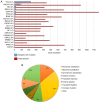Triple-negative breast cancer: A run-through of features, classification and current therapies
- PMID: 33986872
- PMCID: PMC8114477
- DOI: 10.3892/ol.2021.12773
Triple-negative breast cancer: A run-through of features, classification and current therapies
Abstract
Breast cancer is the most prevalent cancer in women worldwide. Triple-negative breast cancer (TNBC) is characterized by the lack of expression of estrogen receptor, progesterone receptor, and human epidermal growth factor receptor 2. It is the most aggressive subtype of breast cancer and accounts for 12-20% of all breast cancer cases. TNBC is associated with younger age of onset, greater metastatic potential, higher incidence of relapse, and lower overall survival rates. Based on molecular phenotype, TNBC has been classified into six subtypes (BL1, BL2, M, MES, LAR, and IM). TNBC treatment is challenging due to its heterogeneity, highly invasive nature, and relatively poor therapeutics response. Chemotherapy and radiotherapy are conventional strategies for the treatment of TNBC. Recent research in TNBC and mechanistic understanding of disease pathogenesis using cutting-edge technologies has led to the unfolding of new lines of therapies that have been incorporated into clinical practice. Poly (ADP-ribose) polymerase and immune checkpoint inhibitors have made their way to the current TNBC treatment paradigm. This review focuses on the classification, features, and treatment progress in TNBC. Histological subtypes connected to recurrence, molecular classification of TNBC, targeted therapy for early and advanced TNBC, and advances in non-coding RNA in therapy are the key highlights in this review.
Keywords: clinical trials; metastatic; overall response rate; targeted therapy; triple-negative breast cancer.
Copyright: © Manjunath et al.
Conflict of interest statement
The authors declare that they have no competing interests.
Figures




References
-
- Sung H, Ferlay J, Siegel RL, Laversanne M, Soerjomataram I, Jemal A, Bray F. Global cancer statistics 2020: GLOBOCAN estimates of incidence and mortality worldwide for 36 cancers in 185 countries. CA Cancer J Clin. 2021 Feb 4; doi: 10.3322/caac.21660. (Epub ahead of print). doi: 10.3322/caac.21660. - DOI - PubMed
Publication types
LinkOut - more resources
Full Text Sources
Research Materials
Miscellaneous
